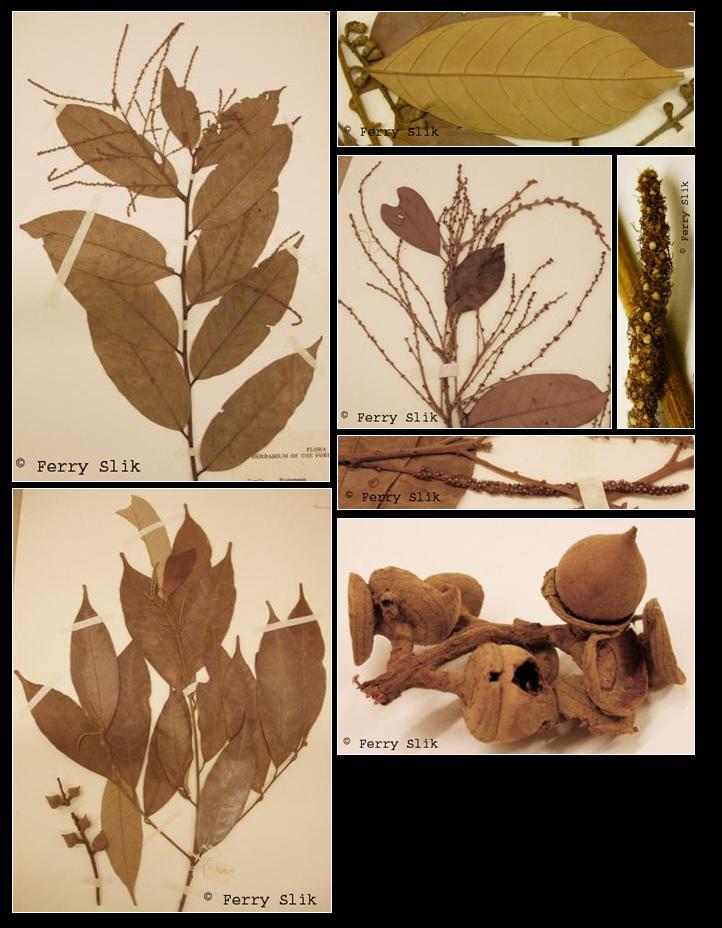Lithocarpus conocarpus (Oudem.) Rehd., J. Arn. Arb. 1 (1919)
Latin for 'cone-shaped fruit'.Synonyms
Cyclobalanus conocarpa (Oudem.) Oerst
Lithocarpus conocarpa ssp. malaccensis A.Camus
Pasania conocarpa (Oudem.) Schottky
Quercus conocarpa Oudem.
Synaedrys conocarpa (Oudem.) Koidz.
Diagnostics
Mid-canopy tree up to 45 m tall and 90 cm dbh. Stipules ca. 2.5 mm long.
Leaves alternate, simple, penni-veined, hairy below, secondary venation looping
and conspicuous. Flowers ca. 2 mm diameter, white-yellow, placed in racemes.
Fruits ca. 16 mm long, green-yellow-brown, hairy nut with basal cupule.
Description
Tree up to 45 m tall, 90 cm diameter. Bark scaly, greyish brown; inner bark granular,
reddish or brownish. Sapwood yellowish. Twigs densely tomentose with simple-erect and
stellate hairs, late-subglabrescent, sparsely to densely lenticellate. Stipules ovate, 2-3 x
1.5 mm. Leaves coriaceous, densely tomentose with stellate and simple hairs above, densely
appressed yellowish tomentose with simple-erect and stellate hairs below; elliptic or
obovate, (6-)8-11(-14) x (2-)3-4.5(-5.5) cm, base acute, sometimes asymmetrical, margin
revolute, apex acute to acuminate, acumen 10-15(-20) mm long; midrib raised on both
surfaces; lateral veins thin, 10-12(-16) pairs, dense or lax, flat or impressed above, raised
below, clearly joining near the leaf margin, forming an angle of 40-60 degrees with the midrib;
intercostal venation subscalariform, dense, obscure above, prominent below; petiole 5-
8 mm long. Inflorescences male, androgynous or mixed. Male inflorescences 8-16 cm
long; bracts and bracteoles linear, 0.3-1.2 x 0.1-0.4 mm. Male flowers solitary along
the rachis; perianth lobes rounded, c. 1 mm across; stamen filaments c. 2 mm long; pistillode
globose, 0.5-1 mm diameter. Androgynous or mixed inflorescences 7-12 cm long; bracts
ovate, c. 1 x 0.5 mm; bracteoles elliptic, c. 0.6 x 0.4 mm. Female flowers solitary along
the rachis; perianth lobes acute c. 1 x 0.5 mm; staminodes 12; styles cylindrical, straight,
c. 1 mm long. Cupules solitary and distantly spaced along the rachis, with stalk 3-
8 mm long, cup-shaped, 0.4-0.8(-1) x 1.3-2 cm, densely tomentose with simple, erect
hairs, lamellate; wall thin, densely tomentose, enclosing up to half of the acorn; lamellae
slightly distinct, edge denticulate or rarely entire, set in 5-6 regular lines. Acorns conical
or ovoid, 1.6-2 x 1.3-1.5 cm, most part exserted, densely tomentose with simple, erect
hairs, rarely glabrescent, dark brown; base rounded, apex acute; scar concave or flat,
0.8-1.2 cm diameter; wall woody, thin, most part free from the cupule. [from Tree Flora of
Sabah and Sarawak]
Ecology
In undisturbed mixed dipterocarp, keranga and sub-montane forests up to 1700
m altitude. Usually on hillsides and ridges with clay to sandy soils, also on limestone.
Uses
The timber is locally used for house-building.
Distribution
Peninsular Malaysia, Sumatra, Java, Borneo.
Local names
Borneo: Berangan, Tikalod (Dusun, Bundu Tuhan), Padeh siah, Saled (Kelabit), Palan (Kenyah), Piraus
(Bidayuh).
